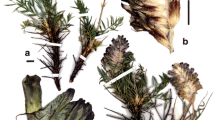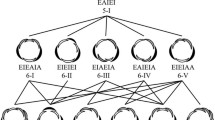Abstract
Angiosperm flowers are subject to spontaneous fluctuations in their structure, so in the same individual plant normal and anomalous flowers may coexist. While extra or missing organs usually do not affect the efficiency of pollination in polysymmetric flowers, such meristic changes may impair the interaction between floral parts in monosymmetric flowers, like in Leguminosae. This work aims to investigate the range of meristic changes in pentamerous pentacyclic flowers of Leguminosae (flag blossoms) and several other eudicot families. Both leguminous and non-leguminous flowers exhibit similar ranges of variation affecting one or several floral whorls, either adjacent or not. The most variable part of the flower is the androecium. In the papilionoid corolla, the most stable part is the adaxial petal (flag), while the most variable feature is the presence or absence of the inner adaxial (vexillary) stamen. This observation agrees with the fact that all petals except for adaxial, as well as vexillary stamen, are recurrently reduced in different leguminous lineages. Among factors potentially contributing to the floral stability, the most significant is inflorescence structure, as highly ramified cymose inflorescences exhibit a wider range of meristic changes in flowers.



Similar content being viewed by others
Data availability
Not applicable.
References
Beer SS, Beer AS, Sokoloff DD (2010) Flower and inflorescence development in Salicornia (Chenopodiaceae). Feddes Repert 121:229–247. https://doi.org/10.1002/fedr.201000024
Bukhari G, Zhang J, Stevens PF, Zhang W (2017) Evolution of the process underlying floral zygomorphy development in pentapetalous angiosperms. Amer J Bot 104:1846–1856. https://doi.org/10.3732/ajb.1700229
Bull-Hereñu K, Ronse De Craene L, Pérez F (2016) Flower meristematic size correlates with heterostylous morphs in two Chilean Oxalis (Oxalidaceae) species. Flora 221:14–21. https://doi.org/10.1016/j.flora.2016.02.009
Caris P (2013) Bloemontogenetische patronen in de Ericales sensu lato. PhD Thesis, Katholieke Universiteit Leuven, Leuven
Choob VV, Penin AA (2004) Structure of flower in Arabidopsis thaliana: spatial pattern formation. Russ J Dev Biol 35:224–227. https://doi.org/10.1023/B:RUDO.0000036712.64312.e8
Donnison IS, Francis D (2002) Models of floral pattern in detached flowers of Silene coeli-rosa (L.) Godr. (Caryophyllaceae). Bot J Linn Soc 140:229–235. https://doi.org/10.1046/j.1095-8339.2002.00092.x
Endress PK (2010) Synorganisation without organ fusion in the flowers of Geranium robertianum (Geraniaceae) and its not so trivial obdiplostemony. Ann Bot (Oxford) 106:687–695. https://doi.org/10.1093/aob/mcq171
Gaudin V, Lunness PA, Fobert PR, Towers M, Riou-Khamlichi C, Murray JAH, Coen E, Doonan JH (2000) The expression of D-Cyclin genes defines distinct developmental zones in snapdragon apical meristems and is locally regulated by the Cycloidea gene. Pl Physiol 122:1137–1148. https://doi.org/10.1104/pp.122.4.1137
Grant S, Hunkirchen B, Saedler H (1994) Developmental differences between male and female flowers in the dioecious plant Silene latifolia. Pl J 6:471–480. https://doi.org/10.1046/j.1365-313X.1994.6040471.x
Han H, Liu X, Zhou Y (2020) Transcriptional circuits in control of shoot stem cell homeostasis. Curr Opin Pl Biol 53:50–56. https://doi.org/10.1016/j.pbi.2019.10.004
Haskell G (1949) Variation in the number of stamens in the common chickweed. J Genet 49:291–301. https://doi.org/10.1007/BF02986082
Hufford L (2001) Ontogeny and morphology of the fertile flowers of Hydrangea and allied genera of tribe Hydrangeeae (Hydrangeaceae). Bot J Linn Soc 137:139–187. https://doi.org/10.1111/j.1095-8339.2001.tb01114.x
Kadyrova LR (2015) Floral polymorphism in Fagopyrum Mill. Res J Pharm Biol Chem Sci 6:1404–1411
Leite VG, Teixeira SP, Godoy F, Paulino JV, Mansano VF (2021) Resolving the non-papilionaceous flower of Camoensia scandens, a papilionoid legume of the core genistoid clade: development, glands and insights into the pollination and systematics of the group. J Pl Res 134:823–839. https://doi.org/10.1007/s10265-021-01293-5
Lyndon RF (1979) Aberrations in flower development in Silene. Canad J Bot 57:233–235. https://doi.org/10.1139/b79-033
Martín-Trillo M, Cubas P (2009) TCP genes: a family snapshot ten years later. Trends Pl Sci 15:31–39. https://doi.org/10.1016/j.tplants.2009.11.003
Matzke EB (1932) Flower variations and symmetry patterns in Stellaria media, and their underlying significance. Amer J Bot 19:477–507. https://doi.org/10.2307/2436072
Naghiloo S, Claßen-Bockhoff R (2017) Developmental changes in time and space promote evolutionary diversification of flowers: a case study in Dipsacoideae. Frontiers Pl Sci 8:1665. https://doi.org/10.3389/fpls.2017.01665
Naghiloo S, Dadpour MR, Movafeghi A (2012) Floral ontogeny in Astragalus compactus (Leguminosae: Papilionoideae: Galegeae): variable occurrence of bracteoles and variable patterns of sepal initiation. Planta 235:793–805. https://doi.org/10.1007/s00425-011-1538-1
Notov AA, Andreeva EA (2016) Monopodial rosette-forming Rosaceae—a model for teratological research. Int J Pl Reprod Biol 8:34–45. https://doi.org/10.14787/ijprb.20168.1.34-45
Payer JB (1857) Traité d’organogénie comparée de la fleur. Victor Masson, Paris
Prenner G, Bateman RM, Rudall PJ (2010) Floral formulae updated for routine inclusion in formal taxonomic descriptions. Taxon 59:241–250. https://doi.org/10.1002/tax.591022
Remizowa MV (2019) One upward, two steps down: order of floral organ initiation. Russ J Dev Biol 50:325–340. https://doi.org/10.1134/S1062360419060080
Ronse De Craene L (2016) Meristic changes in flowering plants: how flowers play with numbers. Flora 221:22–37. https://doi.org/10.1016/j.flora.2015.08.005
Ronse De Craene L, Bull-Hereñu K (2016) Obdiplostemony: the occurrence of a transitional stage linking robust flower configurations. Ann Bot (Oxford) 117:709–724
Ronse De Craene LP, Smets EF, Vanvinckenroye P (1998) Pseudodiplostemony, and its implications for the evolution of the androecium in the Caryophyllaceae. J Pl Res 111:25–43. https://doi.org/10.1007/BF02507147
Sinjushin AA (2021) Evolutionary history of the leguminous flower. Biol Bull Rev 11:400–413. https://doi.org/10.1134/S2079086421040083
Sinjushin AA, Karasyova TA (2017) Stability of the floral structure in Leguminosae with flag versus non-flag blossom. Wulfenia 24:1–10
Sinjushin AA, Bykova EA, Choob VV (2019) Interaction between floral merism and symmetry: evidence from fasciated mutant of Lupinus angustifolius L. (Leguminosae). Symmetry 11:321. https://doi.org/10.3390/sym11030321
Soulé ME (1982) Allomeric variation. 1. The theory and some consequences. Amer Naturalist 120:751–764. https://doi.org/10.1086/284028
Sterk AA (1970) Reduction of the androecium in Spergularia marina (Caryophyllaceae). Acta Bot Neerl 19:488–494
Tikhodeyev ON (2013) Classification of variability forms by key factors determining the phenotype: traditional views and their modern revision. Ekol Genet 11:79–92 (In Russian)
Tucker SC (2003) Floral development in legumes. Pl Physiol 131:911–926. https://doi.org/10.1104/pp.102.017459
Wei L, Ronse De Craene L (2020) Hofmeister’s rule’s paradox: explaining the changeable carpel position in Caryophyllaceae. Int J Pl Sci 181:911–925. https://doi.org/10.1086/710493
Zakharov VM, Shadrina EG, Trofimov IE (2020) Fluctuating asymmetry, developmental noise and developmental stability: future prospects for the population developmental biology approach. Symmetry 12:1376. https://doi.org/10.3390/sym12081376
Acknowledgements
Author expresses his sincere gratitude to Dr. Louis Ronse De Craene for helpful suggestions on literature sources and for stimulating criticism, to Dr. Pieter Caris for sharing his Ph.D. thesis on floral ontogeny in Ericales, to Dr. Ksenia Egorova for collecting material of B. crassifolia, to Margarita Markova for assistance in collecting material of several taxa, to Irina Markova for kind permission to sample H. paniculata, and to anonymous reviewers for helpful comments.
Funding
This work has received no external funding.
Author information
Authors and Affiliations
Corresponding author
Ethics declarations
Conflict of interest
The author declares that he has no conflict of interests.
Additional information
Handling Editor: Louis P. Ronse De Craene.
Publisher's Note
Springer Nature remains neutral with regard to jurisdictional claims in published maps and institutional affiliations.
Electronic supplementary material
Below is the link to the electronic supplementary material.
Information on Electronic Supplementary Material
Information on Electronic Supplementary Material
Online Resource 1. Frequencies of different merism in studied species.
Online Resource 2. Anomalous morphology of the leguminous gynoecia (SEM images).
Rights and permissions
Springer Nature or its licensor (e.g. a society or other partner) holds exclusive rights to this article under a publishing agreement with the author(s) or other rightsholder(s); author self-archiving of the accepted manuscript version of this article is solely governed by the terms of such publishing agreement and applicable law.
About this article
Cite this article
Sinjushin, A. Unequal stability of different parts in the flag blossom (Leguminosae) with notes on factors affecting variability of pentamerous pentacyclic angiosperm flowers. Plant Syst Evol 309, 1 (2023). https://doi.org/10.1007/s00606-022-01837-9
Received:
Accepted:
Published:
DOI: https://doi.org/10.1007/s00606-022-01837-9




